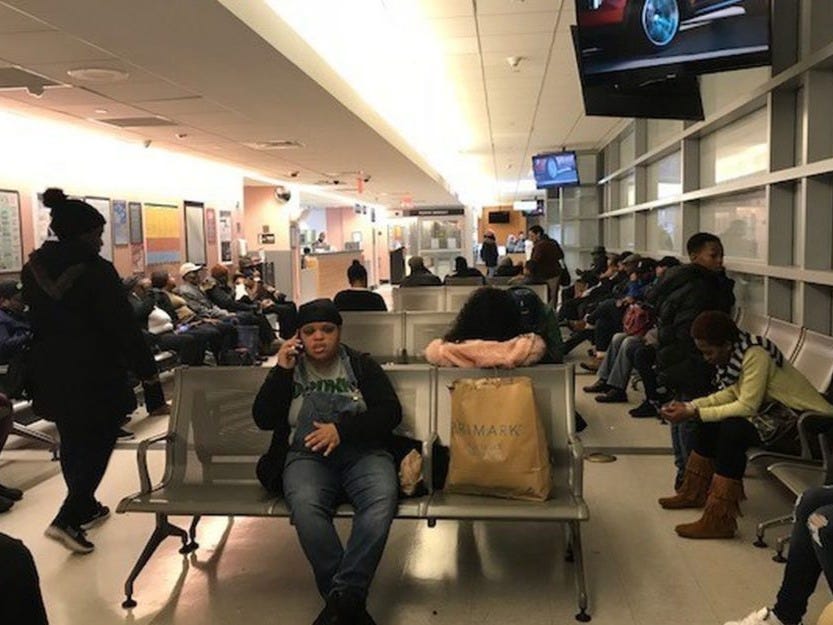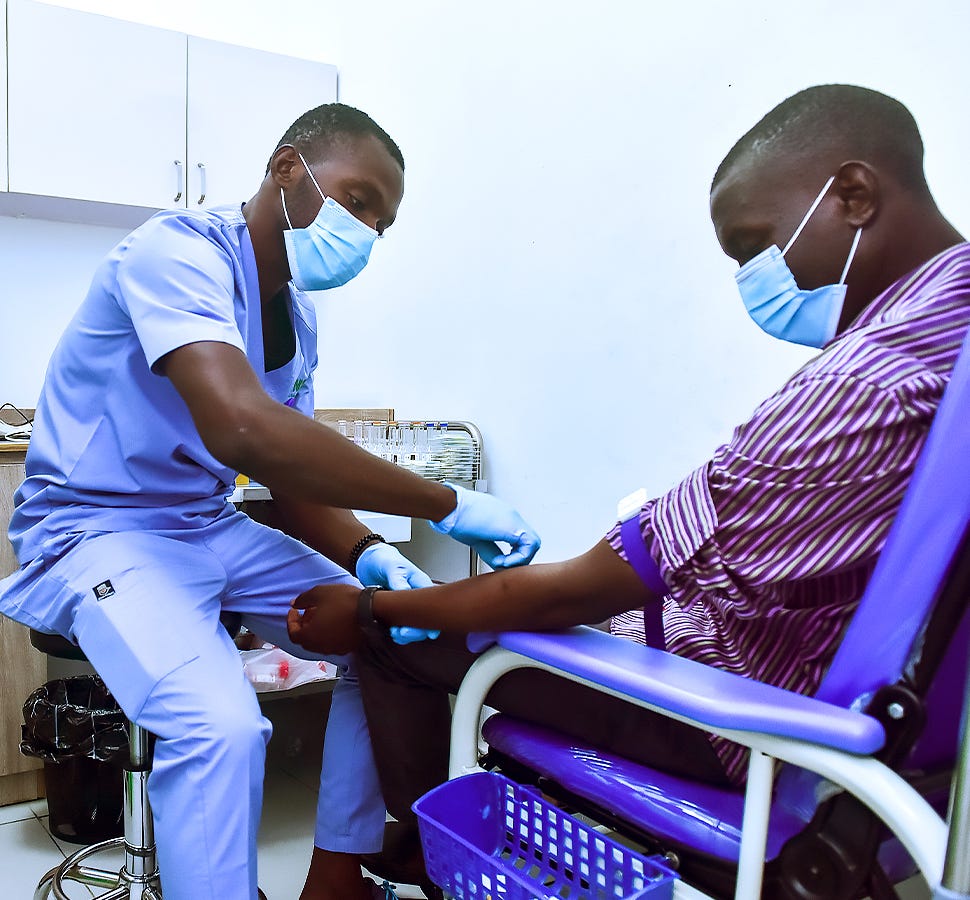AIM
To explore the relationship between health insurance access and accurate laboratory diagnosis concerning health equity.
GIVEN
Health Equity, Diagnosis, Medical Discrimination, Health Insurance, Diagnostic Inequity, Nigeria, Laboratory Science
METHOD
Expository Essay
PRINCIPLE
“20, 21, 22…” Ezekiel* muttered, brow furrowed, as he paced the floor of the hospital’s waiting room. He had been waiting for his Health Maintenance Organization (HMO) to confirm with the receptionist what was covered by his plan for over two hours now. “What even is the point?” He said to himself as he plopped down on the uncomfortable bench. He tried to play a game of colors – how many people wore red out of 10 patients? but he soon got bored. His mind wandered to the day he got the confirmation of his HMO plan. He had just gotten the job as a Center Manager at his company and the plan came as part of the benefits of the role. He remembered his grand plans of finally being able to go to therapy, get his eyes checked, run an annual seminal fluid analysis and run a scan for his back that has been aching forever– these plans had quickly proven baseless because his HMO was the most disjointed of systems. Whenever he presents his plan at the hospital or wherever he theoretically is supposed to, he is met with long wait times, poor customer relations, and most recently cancellation and modification of doctor’s prescriptions and test orders. If he earned enough, Ezekiel would rather do without the HMO plan.
HMO plans and systems emerged to provide private health insurance (PHI) to the corporate sector in 1996 as a more standardized form of the Nigerian Health Insurance Scheme. However, with several people in Ezekiel’s boat, it has proven to be the same side of the dysfunctional health cost alleviation coin.
Health insurance in its most basic form is a contract that provides financial protection and helps reduce healthcare costs for individuals or organizations. Unfortunately, the system of health insurance obtainable in our country has been seen to drive health inequity and impact accurate diagnosis negatively. Individuals who seek healthcare solutions under the umbrella of health insurances are often treated as second fiddles and offered subpar care in comparison to individuals who pay out of pocket.

PROCEDURE:
GLOBAL AND NATIONAL HEALTH EQUITY
The World Health Organization defines health equity as the absence of avoidable or remediable differences among groups of people whether defined socially, economically, demographically or geographically, or by other dimensions of inequality. In practice, health equity goes beyond equal access; it considers the varying needs of individuals and communities and aims to distribute resources accordingly. However, globally and by extension in Nigeria, health equity remains a distant concept. Some studies have shown that women wait longer on average for medical care when they visit the emergency department than men. Women also experience significant delays in the treatment of many conditions, including bleeding disorders and lupus. Black people often experience racial bias that may prevent them from receiving emergency care. A 2019 research stated that doctors in emergency departments might be less likely to classify black and Latinx children as requiring emergency care, admit them to the hospital after a visit, or order tests such as blood work, CT scans, or X-rays compared to white children. Outside of gender and race other root causes of discrimination may include religion, sexuality, age, socioeconomic status, beauty standard, age, etc.
For a country like Nigeria with systemic rot, this disparity is only made worse by the conditions of existence within the borders of the nation. Access to healthcare is hindered by systemic issues like underfunded public health infrastructure, geographic disparities, long waiting times, and high out-of-pocket costs. Urban dwellers may have better proximity to healthcare services, but quality is inconsistent. In rural areas, access is even more limited, with many communities lacking basic diagnostic facilities or qualified personnel. It would interest you to know that healthcare professionals who you would assume had all the access to the resources are not immune to these barriers. Many healthcare workers rely on public hospitals that are limited in funding and resources. Others must pay out-of-pocket for specialized services, despite working within the healthcare system. The irony of caregivers being unable to access care themselves underscores the deep-rooted inefficiencies and inequities within the system. Some months ago, the news of a house officer’s death made the rounds and it was alleged that he couldn't seek the help he needed from the hospital he worked at. Many such cases open our eyes to the irony of healthcare access even for healthcare workers.
One would think that the burden of these barriers would become easier on individuals who hold insurance plans as this is the entire essence of the contract drawn between both parties. This is not the reality. In fact, insurance has been proven to be a contributory factor to health inequality. In many healthcare systems, insurance coverage determines access. Not all insurance plans are created equal. In both public and private systems, coverage of healthcare solutions as well as laboratory tests often varies and what is considered “medically necessary” may lead to the exclusion of important screenings or follow-up. For instance, many preventive diagnostic services and even some pressing diagnostic services are not covered under certain plans. These can range from CT scans, MRIs, specialist consultations, and newer drug therapies. Non-routine tests like hormonal assays, organ function tests, radiology, and biopsies are often considered either too expensive or unnecessary to be covered by health insurance. This leaves patients battling gatekeeping policies, hefty out-of-pocket payments, and incomplete consultations all of which does no good.
On the other side of the divide uninsured individuals often face full out-of-pocket costs which leads to test avoidance or delay. This leads to later-stage disease detection and higher overall healthcare costs in the long run - a paradox in a system that is hinged on reducing the cost of healthcare.
Why then are we still holding on to this system?
THE STATE OF HEALTH INSURANCE IN NIGERIA.
Nigeria's formal health insurance system began with the establishment of the National Health Insurance Scheme (NHIS) in 1999, designed to provide accessible and affordable healthcare to Nigerians. However, the NHIS faced numerous challenges, including limited coverage and operational inefficiencies prompting its transition to the National Health Insurance Authority in May 2022. Outside of this, There are 84 Health Maintenance Organizations (HMOs) accredited by the National Health Insurance Authority (NHIA) in Nigeria. These HMOs are part of the National Health Insurance Scheme (NHIS) and also operate in the private sector. There are also private HMOs beyond the jurisdiction of the NHIA.
Statistics show that out of the >200 million people in Nigeria, only 19 million are covered by any form of health insurance as of 2024 with most enrollees coming from the formal sector. Informal sector workers, rural dwellers, and unemployed people who make up the bulk of the population remain uninsured. As a result, over 70% of health spending in Nigeria is out of pocket, a burden that often forces patients to forgo essential diagnostics. One of the incongruities of health insurance in Nigeria is that even among those enrolled in a scheme whether through the National Health Insurance Authority (NHIA) or a private plan, many still shoulder the majority of their healthcare expenses.

There is also a quality and availability gap. Enrollees often encounter long waiting times, poor-quality service, or denial of services at NHIS-accredited facilities, pushing them to seek care at non-accredited or private centers. Since those providers are out-of-network, patients must pay in full—even when they are technically insured. In some public facilities, patients may be asked to make informal payments or “facilitation fees” for services that should be covered. These under-the-table payments further increase the cost burden on patients and reflect deeper governance and accountability issues.
This reality reduces public trust in the health insurance system and discourages enrollment and renewal. If people are not assured of real financial relief, they would see no need to enroll in a system that would ultimately cost more than outright out-of-pocket payments. When the population, especially with the peculiarities of our country, finds another excuse to distrust healthcare systems, the national health is affected and a straight line can be drawn to its impact on diagnosis.
DIAGNOSIS: A VICTIM OF INSURANCE AND INEQUITY.
The healthcare landscape of Nigeria is a territory that in itself performs poorly as it is limited by several factors including inadequate funding, poor infrastructure, a shortage of skilled health workers, unevenly distributed services and resources, corruption and weak policy implementation, cultural beliefs, stigma, and poor health-seeking behavior. This landscape makes it difficult to achieve timely and accurate diagnosis – a multifaceted process that depends on access to qualified healthcare professionals, diagnostic tests, follow-up consultations, and the ability to pay for all of the above. The systemic issues we have explored concerning health insurance provision do not exist in a void but directly impact diagnosis creating gaps that hinder effective healthcare delivery.. For instance, a 2023 report from the Nigerian Cancer Society highlighted that over 70% of cancer cases in Nigeria are diagnosed at advanced stages, largely due to financial barriers to diagnostic imaging and histopathology. In the absence of confirmatory tests, healthcare providers rely on clinical judgment and trial therapies, increasing the risk of misdiagnosis and antimicrobial resistance. Insurance schemes do not adequately support integrated care across different levels of the health system. Patients may receive a consultation at a primary facility but be unable to afford diagnostic referrals to secondary or tertiary centers. Patients begin to view diagnostic testing as a luxury rather than a necessity, fostering a culture of minimal testing and self-medication.
In Nigeria, health-seeking behavior (how individuals perceive/respond to symptoms, access care, and utilize healthcare services) is also deeply influenced by the systemic limitations of the health insurance industry. One of the most prominent effects is delayed or avoided care. When patients anticipate high out-of-pocket expenses for diagnostic tests not covered by insurance, they may postpone seeking help until symptoms become severe. This delay contributes to disease progression and worsens prognosis. The perceived lack of value from health insurance schemes also discourages enrollment and participation. This disillusionment fuels distrust in the formal healthcare system and drives patients toward informal alternatives—such as self-medication, traditional healers, or unregulated drug vendors. Furthermore, fragmented diagnostic access affects patient motivation. In many cases, individuals must navigate complex referral systems or travel long distances to reach insurance-accredited or diagnostic-equipped facilities. Ultimately, the absence of accessible, affordable, and insured diagnostic services creates a vicious cycle: patients avoid the health system due to anticipated burdens, health conditions worsen without timely diagnosis, and the burden on tertiary care facilities increases as patients present with advanced, complicated illnesses.
COMMENTS:
HOW DO WE BELL THE CAT?
Now that we have pointed fingers and beaten the drums of what is warped in our healthcare insurance system, what next? We can all agree that this is an elephant that needs to be surmounted if we desire to produce accurate diagnoses as medical laboratory scientists or contribute to the healthcare delivery system as health care workers.
In reimagining Nigeria’s healthcare landscape, it is imperative to recognize that diagnostic equity cannot be achieved without a functional and inclusive health insurance framework. Insurance must serve its core purpose of protecting patients from expensive healthcare while enabling timely and accurate diagnoses across all socioeconomic classes. Addressing the current inefficiencies in insurance policy coverage, administrative delays, provider bias, and patient mistrust calls for not just policy overhauls but collaboration across government, private sector, and healthcare professionals.
RECOMMENDATIONS:
The Yorubas would say ibi pelebe laa ti n mu ole je (we eat the moi-moi from its flattest part). This means that we begin from the beginning.
To reduce diagnostic inequity and improve the effectiveness of health insurance in Nigeria, the following actions are recommended:
Expand Diagnostic Coverage Under Insurance Plans:

Credit: Freepik To improve diagnostic equity, health insurance schemes must include a broader range of essential laboratory and imaging services. As medical laboratory scientists saddled with the responsibility of finding answers in biological samples towards diagnosis, we must provide our facilities with a more robust set of tests that are essential to be covered by the Health Maintenance Organization. This would help to bridge the diagnostic gap. Health insurance schemes must cover a broader range of diagnostic services. There should be a clearly defined essential diagnostic benefit package under both public and private insurance schemes. This package should cover routine laboratory tests, imaging, preventive screenings, and some select specialized tests (e.g., biopsies, hormonal panels, tumor markers). The National Health Insurance Authority (NHIA) must work with medical laboratory experts and economists to prioritize these diagnostic tests based on disease prevalence, cost-effectiveness, and health impact.
Strengthen the Regulation and Oversight of HMOs:
To address diagnostic inequity and improve access to healthcare, stronger regulation and oversight of both public and private health insurance sectors are essential. The alliance between these sectors must be governed by policies that prevent exploitation, particularly by private HMOs that often offer limited coverage while imposing hidden costs. Regulatory frameworks should ensure that insurance plans provide comprehensive and transparent benefits, with standardized minimum coverage for essential diagnostic services. This would reduce the high out-of-pocket expenses currently borne by patients. With effective policy enforcement, out-of-pocket costs can be significantly lowered, preserving the core purpose of health insurance as a financial buffer and reducing the risk of patients avoiding necessary care due to cost.
Train Healthcare Professionals on Insurance Ethics and Equal Care:
Additionally, healthcare professionals must undergo a pivotal shift in attitude when interacting with clients who are covered by health insurance or HMOs. At the core of our professional ethics are the principles of beneficence and justice which states that we are duty-bound to act in the best interest of our patients and ensure fairness in all medical decisions, including access to care and the allocation of resources. This ethical commitment extends to treating all patients equally, regardless of how they pay for their care. Insurance status should never influence the quality of service rendered. Every patient, whether insured or paying out-of-pocket, deserves the same level of professionalism, dignity, and quality care. In practice, this means minimizing unnecessary delays, offering attentive and respectful communication, and delivering thorough, unbiased treatment to all.
Launch Nationwide Public Education Campaigns:

Credit: CNN All of these reforms would, however, be ineffective if the populace remains uninformed or misinformed—particularly about the role of health insurance in accessing diagnostics. Many Nigerians, especially in rural or low-income communities, still view health insurance as an unnecessary deduction and diagnostic services as luxuries rather than critical components of preventive healthcare. This perception delays early testing, worsens health outcomes, and discourages enrollment in insurance schemes. To counter this, governments, insurance regulators, healthcare providers, and community leaders must collaborate to drive grassroots education campaigns that communicate the benefits of health insurance, especially in making diagnostic services more affordable and accessible. These efforts should use relatable success stories, local language media, and community influencers to debunk myths about laboratory testing, promote early detection, and guide citizens in choosing the right insurance plans. Sensitization must also include practical knowledge of patient rights under insurance schemes and how to seek redress when coverage is unfairly denied. If properly executed, such campaigns will not only reshape public perception but also increase participation in health insurance and encourage a culture of proactive healthcare-seeking.
Ultimately, health equity is not an abstract ideal. By investing in transparent, patient-centered insurance systems, expanding diagnostic coverage, educating the public, and cultivating ethical practice among providers, Nigeria can move closer to a future where access to accurate diagnosis is not a privilege, but a right. The journey to that future starts now with accountability, informed reform, and an unwavering commitment to the well-being of all.







